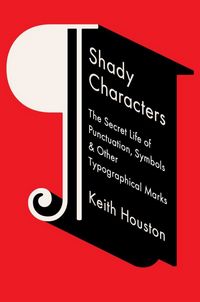 Shady Characters: The Secret Life of Punctuation, Symbols & Other Typographical Marks
Shady Characters: The Secret Life of Punctuation, Symbols & Other Typographical Marks
Hardcover, 246 pg.
W. W. Norton Company, 2013
Read: August 7 – 16, 2019

| When the quotation mark does succeed in sparking debate, it attracts mild tut-tutting rather than genuine outrage. Though there is transatlantic disagreement over whether to enclose speech in ‘single’ or “double” quotes, for instance, it comes nowhere near the level of hand-wringing inspired by the semicolon, whose tricky usage has driven it almost to extinction. Neither does the occasional unnecessary “use” of quotation marks induce the howling apoplexy provoked by a simple misplaced apostrophe: whereas one English council was driven to institute an apostrophe “swear box,” café menu offers of “freshly baked ‘bagels,”’ “‘fresh fish,” and the like attract typically little more than a genteel ribbing. Unlike the “Oxford,” or serial, comma, quotation marks or “inverted commas” have never become a trending topic on Twitter, nor have they inspired a pop song in their name. |
If that paragraph (from the chapter on quotation marks) or the fact that there’s an entire chapter on quotation marks doesn’t indicate it to you already, let me assure you that this is a book for grammar nerds (or would-be grammar nerds). For a little more flavor, the U. S. subtitle is “The Secret Life of Punctuation, Symbols, & Other Typographical Marks,” in the U.K., it’s “Ampersands, Interrobangs and Other Typographical Curiosities.”
The book is a historical survey of typography and language as manifested in particular punctuation marks, symbols, and other typographical marks. How they developed, how they’ve been used, and how they are used now. Specifically they are: the pilcrow (¶—you may have seen those around here); the interrobang (‽); the octothorpe (#); the ampersand (&); the @ symbol; the asterisk and dagger (* †); the hyphen (‐); the dash ( ‒ – — ―); the manicule (☞); quotation marks (‘ ’ “ ” ‘ ‘ ” “); and the various attempts to come up with a symbol, typology, or punctuation denoting irony, sarcasm or humor.*
* And I really wish I knew how that paragraph was going to display cross-browsers, devices and in the various places I’ll post this…
The afterward does a pretty good job of describing the book as a whole:
| This book, as it turns out, is not just about unusual marks of punctuation, nor even punctuation in general. In following the warp and woof of individual shady characters throughout their lifetimes, it is the woven fabric of writing as a whole that emerges. And in today’s writing, the printed and electroluminescent characters we read on a daily basis and the scrawled handwriting that occupies the diminishing gaps between computer monitors, tablet computers, and smartphone screens, this history stares right back at us. |
You don’t have to read this book from cover to cover, you can dip in and read about a particular mark/symbol that you’re curious about and move on. But the chapters do build on each other, and things that are discussed in (for example) the pilcrow chapter will come back for the manicule, the interrobang will inform the ironic/sarcasm indicators, and the octothorpe chapter will come back with the @ and dash chapters. So you’d do well to read it from cover to cover.
It’s not just the individual marks/symbols that you learn about, but the hyphen chapter is a lesson (in a nutshell) on typography in books from Gutenberg to digital publishing. The asterisk and dagger chapter showed a surprising connection between those symbols (and their usage) and the Protestant Reformation, Luther in particular.
The origin alone of the name “ampersand” (and the various attempts at explaining “octothorpe” and the alternatives) are just amusing enough to justify buying a copy of this to have on hand for reference. The history of the ampersand is almost as interesting as the name, too. The reason that @ was used in e-mail addresses — and essentially shaped how much of the world’s communication in the few decades since then is a great example that it’s not just butterflies flapping their wings in China that can make a huge impact on the other side of the world.
Naturally, not all chapters are equally interesting — and that’s going to be a matter of taste — and the more technical bits of individual chapters are easily skimmable until Houston moves on to another aspect of the mark in question or on to the next chapter. I will admit I did that a time or two, but he always got me back within a chapter.
I really wish I could remember how this got on my radar a couple of weeks ago, so I could give a hat-tip and some thanks, I had a great time with this book. Well-illustrated (both anecdotally and with pictures), and with a great mix of style, wit and substance — Shady Characters is a great way for a grammar geek to spend a day or two basking in the things that provide ornamentation to writing and our books. i do recommend it, and am glad I came across it.
—–




wittysarcasticbookclub
I need this book!
Ola G
This sounds entertaining – and pretty enlightening as well! ?